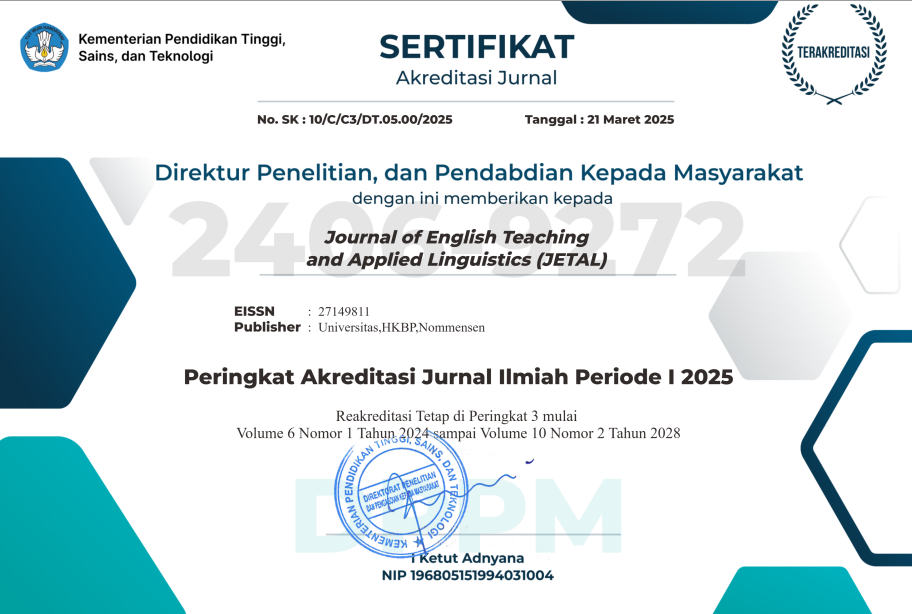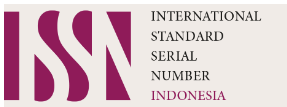Flipping the Page: Engaging Elementary Literacy with Interactive Storybooks
Abstract
Literacy skills still become a serious challenge for elementary school students in Indonesia. Thus, this research aimed to develop interactive storybooks to support literacy activities at elementary schools. This study can be classified as a research and development study following the Successive Approximation Model. Study data were collected from teachers and students at one of the elementary schools in Bali through interviews, documentation, expert judgment, and questionnaires. Data were analyzed qualitatively and quantitatively. Interview and documentation results underwent qualitative analysis using interactive data analysis models. Expert judgment results were analyzed using the inter-rater agreement model, while questionnaire results were analyzed descriptively and categorized using intervals derived from theoretical ideal reference assessments. The findings revealed a strong preference among students for flipbooks with vibrant illustrations, animal characters, smartphone compatibility, and interactive quizzes. The expert judgment further confirmed the suitability of the content for children and its ability to improve students' understanding of narratives. Besides, students’ feedback indicated high acceptance and enthusiasm for the developed flipbooks. However, it is essential to note that the limitation of the study lies in the evaluation regarding the impact of flipbooks on students' literacy skills, which was not conducted. Therefore, it is crucial to conduct a further study utilizing experimental methodology to validate their effectiveness in improving elementary school student’s literacy.
References
Abidin, N. R. Z. (2020). Literasi Membaca Sebagai Upaya Pembentuk Karakter Peserta Didik (Jujur dan Bertanggung Jawab). Seminar Nasional Pascasarjana 2020, 3(1), 791–797. https://proceeding.unnes.ac.id/index.php/snpasca/article/view/669
Aditya Dharma, I. M. (2019). Pengembangan Buku Cerita Anak Bergambar Dengan Insersi Budaya Lokal Bali Terhadap Minat Baca Dan Sikap Siswa Kelas V Sd Kurikulum 2013. Journal for Lesson and Learning Studies, 2(1), 53–63. https://doi.org/10.23887/jlls.v2i1.17321
Altay, B. (2014). User-centered design through learner-centered instruction. Teaching in Higher Education, 19(2), 138–155. https://doi.org/10.1080/13562517.2013.827646
Ananta, I., Assyifa, F. Z., Chairunnisa, K., & Dayu, D. P. K. (2022). Media Pembelajaran Let’s Read Meningkatkan Literasi Membaca pada Pembelajaran Kurikulum Merdeka. Prosiding Seminar Nasional Bahasa, Sastra, Seni, Dan Pendidikan Dasar (SENSASEDA), 2(November), 31–36. https://mathdidactic.stkipbjm.ac.id/index.php/sensaseda/article/view/1969
Anggriani, M., Rijalul Akbar, M., Mulyadi, & Widayati, U. (2022). Pengembangan Buku Cerita Bergambar Interaktif Berorientasi Literasi dan Pendidikan Karakter Siswa untuk Meningkatkan Kemampuan dan Minat Membaca Kelas V SDN 63 Dodu Kota Bima. Jurnal Pendidikan Bahasa, 12(2), 1–10.
Asman, A., & Dewi, D. . (2022). Kegiatan literasi untuk meningkatkan kemampuan berbicara bahasa inggris pada anak-anak di desa Sesaot. Jurnal Pengabdian kepada Masyarakat Cahaya Mandalika, 3(1), 44–50.
Azizah, I. A., & Sucahyo, I. (2022). Flipbook-Based Digital E-book Learning Media on Mechanical Wave Materials to Practice Critical Thinking Skills. Prisma Sains : Jurnal Pengkajian Ilmu Dan Pembelajaran Matematika Dan IPA IKIP Mataram, 10(3), 712. https://doi.org/10.33394/j-ps.v10i3.5474
Budiarsa, I. K., Sudiana, I. N., & Arnyana, I. B. P. (2022). Pengembangan Buku Cerita Berkearifan Lokal Bali Untuk Meningkatkan Kemampuan Literasi Budaya Siswa Kelas Ii Sekolah Dasar. PENDASI: Jurnal Pendidikan Dasar Indonesia, 6(2), 1–11. https://doi.org/10.23887/jurnal_pendas.v6i2.953
Cen, C., Luo, G., Li, L., Liang, Y., Li, K., Jiang, T., & Xiong, Q. (2023). User-Centered Software Design: User Interface Redesign for Blockly–Electron, Artificial Intelligence Educational Software for Primary and Secondary Schools. Sustainability, Vol. 15. https://doi.org/10.3390/su15065232
Ceylan, N. O. (2016). Using Short Stories in Reading Skills Class. Procedia - Social and Behavioral Sciences, 232, 311–315. https://doi.org/https://doi.org/10.1016/j.sbspro.2016.10.027
Chooa, J. C. S., & Singha, M. K. M. (2011). Enhancing Critical Literacy in Writing by Employing Media in Explicit Instructional Approaches. Procedia - Social and Behavioral Sciences, 29, 1409–1417. https://doi.org/https://doi.org/10.1016/j.sbspro.2011.11.380
Cynthia, R. E., & Sihotang, H. (2023). Melangkah bersama di era digital : pentingnya literasi digital untuk meningkatkan kemampuan berpikir kritis dan kemampuan pemecahan masalah peserta didik. Jurnal Pendidikan Tambusai, 7, 31712–31723.
Darmiyanti, A., & Taufik, M. (2021). Multitext Learning: Efforts to Improve Literacy Students in Indonesia. Indonesian Journal of Librarianship, 2(1), 31–40. https://doi.org/10.33701/ijolib.v2i1.1422
Erlianti, G., & Ardoni. (2019). Urgensi Literasi Digital untuk Generasi Z: Studi Kasus SMPN 4 Palembayan, Kabupaten Agam. Nusantara Journal of Information and Library Studies, 2(2), 189–204.
Farodhy, T. Y., & Utami, N. R. (2019). Pengaruh Media Cerita Bergambar Terhadap Kemampuan Literasi Awal Anak Usia 4-5 Tahun. Jurnal Skripta, 5(1), 70–74. https://doi.org/10.31316/skripta.v5i1.1043
Gregory, R. J. (2011). Psychological testing history, principles, and applications. Allyn & Bacon.
Gusmaniarti, G., Agustina, A. W., Vizaa, A. N. H., Karim, A., & Syaqinah, I. P. (2022). Meningkatkan Keingintahuan Anak Melalui Kegiatan Bercerita Pada Kelompok a Di Tk Tamansari Surabaya. Incrementapedia: Jurnal Pendidikan Anak Usia Dini, 4(1), 33–37. https://doi.org/10.36456/incrementapedia.vol4.no1.a6639
Harahap, K., & Hanum, R. (2018). Upaya Meningkatkan Minat Anak Mendengarkan Cerita dengan Menggunakan Media Gambar. Aṭfālunā: Journal of Islamic Early Childhood Education, 1(1), 29–34. https://doi.org/10.32505/atfaluna.v1i1.772
Kartika, & Lestari, M. R. D. W. (2022). Penerapan Sastra Anak Dalam Peningkatan Literasi Siswa Sd Kelas 1. Perspektif, 1(3), 245–250. https://doi.org/10.53947/perspekt.v1i3.79
Khaerunnisa, N., Jumadi, J., Yusri, H., Indahsari, H. K., & Febrian, A. (2023). The Feasibility of Guided Inquiry-Based Digital Flipbook Learning Media: Physics Module in Sensing Systems. Jurnal Pendidikan Fisika Indonesia, 19(1), 16–23. https://doi.org/10.15294/jpfi.v19i1.37133
Kiili, C., & Leu, D. J. (2019). Exploring the collaborative synthesis of information during online reading. Computers in Human Behavior, 95, 146–157. https://doi.org/https://doi.org/10.1016/j.chb.2019.01.033
Mansur, H., & Utama, A. H. (2021). The Evaluation of Appropriate Selection Learning Media at Junior High School. Indonesian Journal of Instructional Media and Model, 3(1), 17. https://doi.org/10.32585/ijimm.v3i1.1401
Miles, B., Huberman, M., & Saldana, J. (2014). Qualitative data analysis: A methods sourcebook. SAGE Pub.
Muñoz-Leiva, F., Climent-Climent, S., & Liébana-Cabanillas, F. (2017). Determinants of intention to use the mobile banking apps: An extension of the classic TAM model. Spanish Journal of Marketing - ESIC, 21(1), 25–38. https://doi.org/https://doi.org/10.1016/j.sjme.2016.12.001
Nasruddin, N., & Setiyadi, M. W. (2023). Development of Assessment Media Using Wondershare Quiz Creator for Evaluation Effectiveness for Teachers in Dompu Regency. Jurnal Pendidikan Ips, 13(2), 334–340. https://doi.org/10.37630/jpi.v13i2.1398
Nasution, R. C. (2019). Pengaruh Kemudahan Penggunaan, Kemanfaatan, Kenyamanan, dan Keamanan Terhadap Minat Menggunakan Perbankan Online (Studi Kasus pada Mahasiswa S1 Fakultas Ekonomi dan Bisnis Universitas Sumatera Utara). Universitas Sumatra Utara.
Navida, I., Rasiman, Prasetyowati, D., & Nuriafuri, R. (2023). Kemampuan Literasi Membaca Peserta Didik Pada Muatan Bahasa Indonesia Kelas 3 di Sekolah Dasar. Jurnal Educatio FKIP UNMA, 9(2), 1034–1039. https://doi.org/10.31949/educatio.v9i2.4901
Nergis, A. (2013). Exploring the factors that affect reading comprehension of EAP learners. Journal of English for Academic Purposes, 12(1), 1–9. https://doi.org/https://doi.org/10.1016/j.jeap.2012.09.001
Neumann, M. M. (2020). Teacher Scaffolding of Preschoolers’ Shared Reading With a Storybook App and a Printed Book. Journal of Research in Childhood Education, 34(3), 367–384. https://doi.org/10.1080/02568543.2019.1705447
Novianti, R., & Riyanto, S. (2018). Tingkat Literasi Media Remaja Desa dalam Pemanfaatan Internet. Jurnal Komunikasi Pembangunan, 16(2), 158–171.
Nurhidayah, S., & Utami, F. (2023). Stimulasi Karakter Komunikatif dan Rasa Ingin Tahu Anak Usia (1-3) Tahun. Jurnal Obsesi : Jurnal Pendidikan Anak Usia Dini, 7(1), 527–535. https://doi.org/10.31004/obsesi.v7i1.3499
Park, Y. (2011). Using news articles to build a critical literacy classroom in an EFL setting. TESOL Journal, 2(1), 24–51. https://doi.org/10.5054/tj.2011.244134
Pohan, S., Pamungkas, Y., Tobing, L., & Mazuda, A. (2023). Preventing the Spread of Hoaxes By Increasing Digital Literacy. Jurnal Scientia, 12(3), 2023. http://infor.seaninstitute.org/index.php
Purnama, S., Ulfah, M., Machali, I., Wibowo, A., & Narmaditya, B. S. (2021). Does digital literacy influence students’ online risk? Evidence from Covid-19. Heliyon, 7(6), e07406. https://doi.org/https://doi.org/10.1016/j.heliyon.2021.e07406
Rachim, D. A., & Ambarwati, R. (2021). Developing an E-Flipbook on Environmental Change Topics To Develop Students’ Digital Literacy. Edusains, 13(1), 25–33. https://doi.org/10.15408/es.v13i1.16893
Rahmadani, E., & Bungawati. (2023). Innovation of Flipbook Teaching Materials in Supporting Student Learning Independence. Mimbar Sekolah Dasar, 11(1), 176–189. https://doi.org/10.53400/mimbar-sd.v11i1.61620
Rahmawati, R., Yandari, I. A. V., Sukirwan, S., & Pamungkas, A. S. (2023). Pengembangan Media Pembelajaran Digital Flipbook Menggunakan Aplikasi Canva Dalam Pembelajaran Tematik Kelas V Sekolah Dasar. JURNAL PENDIDIKAN DASAR PERKHASA: Jurnal Penelitian Pendidikan Dasar, 9(2), 337–350. https://doi.org/10.31932/jpdp.v9i2.2259
Rakhmi, D. I. (2019). Peran Pemberian Cerita Imajinatif Dalam Menurunkan Perilaku Agresif Pada Masa Anak Awal. Naskah Prosiding Temilnas XI IPPI, September, 20–21.
RANI, S. (2022). Penyebab Rendahnya Kemampuan Literasi Anak Kelas Iii Di Sd Negeri 24 Kota Bengkulu Skripsi.
Ridell, K., & Walldén, R. (2023). Graphical models for narrative texts: Reflecting and reshaping curriculum demands for Swedish primary school. Linguistics and Education, 73, 101137. https://doi.org/https://doi.org/10.1016/j.linged.2022.101137
Rodriguez, M. C. G. (2016). Chapter 7 - “The Stories We Tell Each Other”: Using Technology for Resistance and Resilience Through Online Narrative Communities. In S. Y. Tettegah & Y. E. B. T.-E. Garcia Technology, and Health (Eds.), Emotions and Technology (pp. 125–147). Academic Press. https://doi.org/https://doi.org/10.1016/B978-0-12-801737-1.00007-X
Roemintoyo, R., & Budiarto, M. K. (2021). Flipbook as Innovation of Digital Learning Media: Preparing Education for Facing and Facilitating 21st Century Learning. Journal of Education Technology, 5(1), 8. https://doi.org/10.23887/jet.v5i1.32362
Sari, C. P. (2018). Faktor-Faktor Penyebab Rendahnya Minat Membaca Siswa Kelas IV. Jurnal Pendidikan Guru Sekolah Dasar, 7(32), 3128–3137. http://journal.student.uny.ac.id/ojs/ojs/index.php/pgsd/article/viewFile/13875/13400
Sari, S. N., Yulistio, D., & Trianto, A. (2023). Kemampuan Literasi Membaca Pada Siswa Kelas XI SMA Negeri 2 Seluma 1. Jurnal Ilmiah Korpus, 7(1), 2023.
Shao, X., & Purpur, G. (2016). Effects of Information Literacy Skills on Student Writing and Course Performance. The Journal of Academic Librarianship, 42(6), 670–678. https://doi.org/https://doi.org/10.1016/j.acalib.2016.08.006
Sharma, P., & Hannafin, M. (2007). Scaffolding in technology-enhanced learning environments. Interactive Learning Environments, 15(1), 27–46. https://doi.org/10.1080/10494820600996972
Shivers-McNair, A., Phillips, J., Campbell, A., Mai, H. H., Yan, A., Macy, J. F., … Guan, Y. (2018). User-Centered Design In and Beyond the Classroom: Toward an Accountable Practice. Computers and Composition, 49, 36–47. https://doi.org/https://doi.org/10.1016/j.compcom.2018.05.003
Wang, N., Wang, H., Chang, F., Lu, F., & Dill, S.-E. (2020). Factors linked to cultivating successful readers: Evidence from rural China. International Journal of Educational Research, 103, 101636. https://doi.org/https://doi.org/10.1016/j.ijer.2020.101636
Yani, S., Lubis, E., Hasibuan, M., Bengkulu, U. M., Literasi, P., Baca, M., Corner, L., & Interest, R. (2022). Pojok literasi di sekolah dasar negeri 47 desa bajak 1 untuk menumbuhkan minat baca siswa. Pengabdian Masyarakat Mandira Cendekia, 1(12), 45–52.
Yenti, S., Suryana, D., & Mahyuddin, N. (2023). Upaya Meningkatkan Kemampuan Literasi Anak melalui Buku Cerita di Taman Kanak-Kanak Negeri Pembina Painan. Jurnal …, 5(1), 3041–3052. http://journal.universitaspahlawan.ac.id/index.php/jpdk/article/view/11469%0Ahttp://journal.universitaspahlawan.ac.id/index.php/jpdk/article/download/11469/8808
Yuniarrahmana, S., Matsun, M., & Hakim, S. L. (2021). Pengembangan Media Pembelajaran Flipbook Digital Fisika Untuk Siswa Kelas X pada Materi Usaha dan Energi SMA Negeri 1 Matan Hilir Utara. Prisma Fisika, 9(3), 213. https://doi.org/10.26418/pf.v9i3.50073

This work is licensed under a Creative Commons Attribution-ShareAlike 4.0 International License.
Authors retain copyright and grant the journal right of first publication with the work simultaneously licensed under a Creative Commons Attribution-ShareAlike 4.0 International License (CC BY-SA 4.0) that allows others to share the work with an acknowledgment of the work's authorship and initial publication in this journal.
Authors are able to enter into separate, additional contractual arrangements for the non-exclusive distribution of the journal's published version of the work (e.g., post it to an institutional repository or publish it in a book), with an acknowledgment of its initial publication in this journal.
Authors are permitted and encouraged to post their work online (e.g., in institutional repositories or on their website) prior to and during the submission process, as it can lead to productive exchanges, as well as earlier and greater citation of published work (See The Effect of Open Access).






